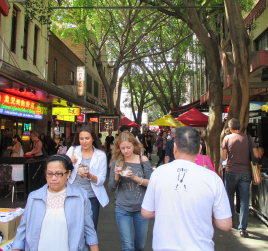The end of sprawl is in sight – in America at least
8 Dec 2016
The tide is turning. Research from the USA suggests there has been a complete reversal in American development, with offices and shops flocking to walkable areas rather than the suburbs.
The report Foot Traffic Ahead was prepared by the George Washington University School of Business, and looks at development patterns in the 30 largest cities in America, supporting 46% of the total US population. It focuses on regionally significant walkable urban places (WalkUPs) – centres within those cities with substantial areas of office and retail space and a Walkscore higher than 70 out of 100.
The report demonstrates that rents are higher in WalkUPs than suburban areas in every single one of the cities studied. For about half the cities, rents in WalkUPs are 50-100% higher. And in most major cities that rental premium is increasing.
The report describes a transformation taking place. “The late 20th century saw the domination of drivable sub-urban development. During this time, historic WalkUPs, which were generally center city downtowns and suburban downtowns, lost market share in virtually every metro area in the country. This situation has been reversed in all of the 30 largest metropolitan areas.”
In the cities studied, the average rental premium for walkable urban office space was 90%, retail 71%, and rental multi-family 66%, over drivable suburbs.
And the most walkable major cities are much richer than the least walkable. The six most walkable major cities have an average GDP per capita of $US72,110, compared to $US48,313 in the seven least walkable major cities. “There is a 49 percent GDP per capita “premium” in the most highly walkable urban metros over the least walkable urban metros. This is a similar to the per capita GDP ratio between Germany and countries like Russia, Latvia, and Croatia.”
Even the most car-oriented cities are feeling the winds of change. “Detroit, Los Angeles, and Phoenix appear just as likely to experience a boom in walkable urbanism. For decades, these three metros sprawled faster than most other metros. But since 2010, their development patterns have experienced a fundamental shift from drivable sub-urban to walkable urban.”
The authors conclude:
“The end of sprawl is in sight. The nation’s largest metropolitan areas are focusing on building walkable urban development. For perhaps the first time in 60 years, walkable urban places (WalkUPs) in all 30 of the largest metros are gaining market share over their drivable sub-urban competition—and showing substantially higher rental premiums. This research shows that metros with the highest levels of walkable urbanism are also the most educated and wealthy (as measured by GDP per capita)— and, surprisingly, the most socially equitable.”
So what does this mean for Australia? Well, Australia often follows the trends in the United States, and this is a good one to follow. And there are clear parallels in Australia. Office jobs in particular are concentrating in walkable city centres and inner suburbs. But in Melbourne about half of new housing is still in new suburbs at the edge of the existing urban sprawl. Is it possible that the nation that gave us the automobile has skipped past us and is now leaving us behind in the race to a walkable future?